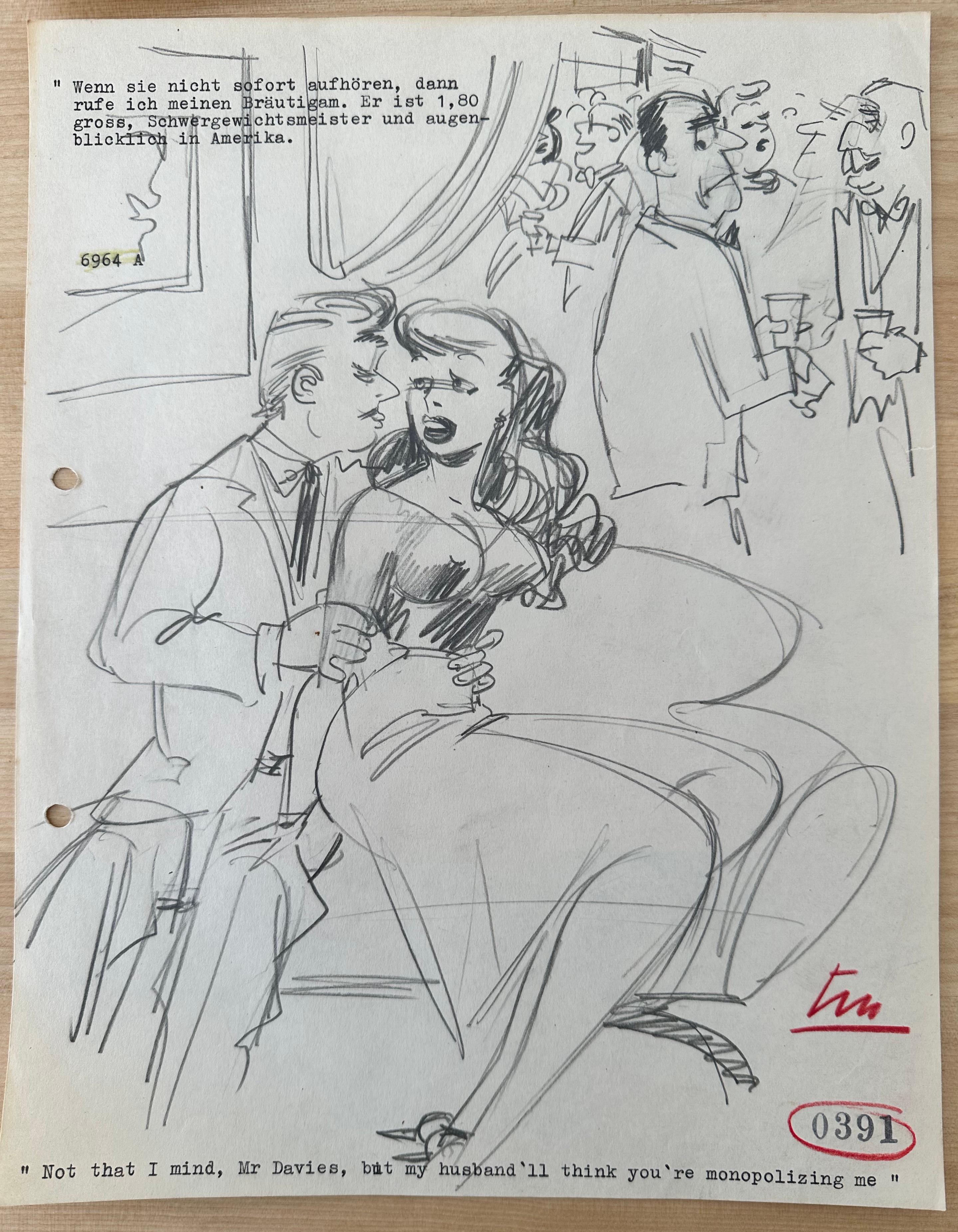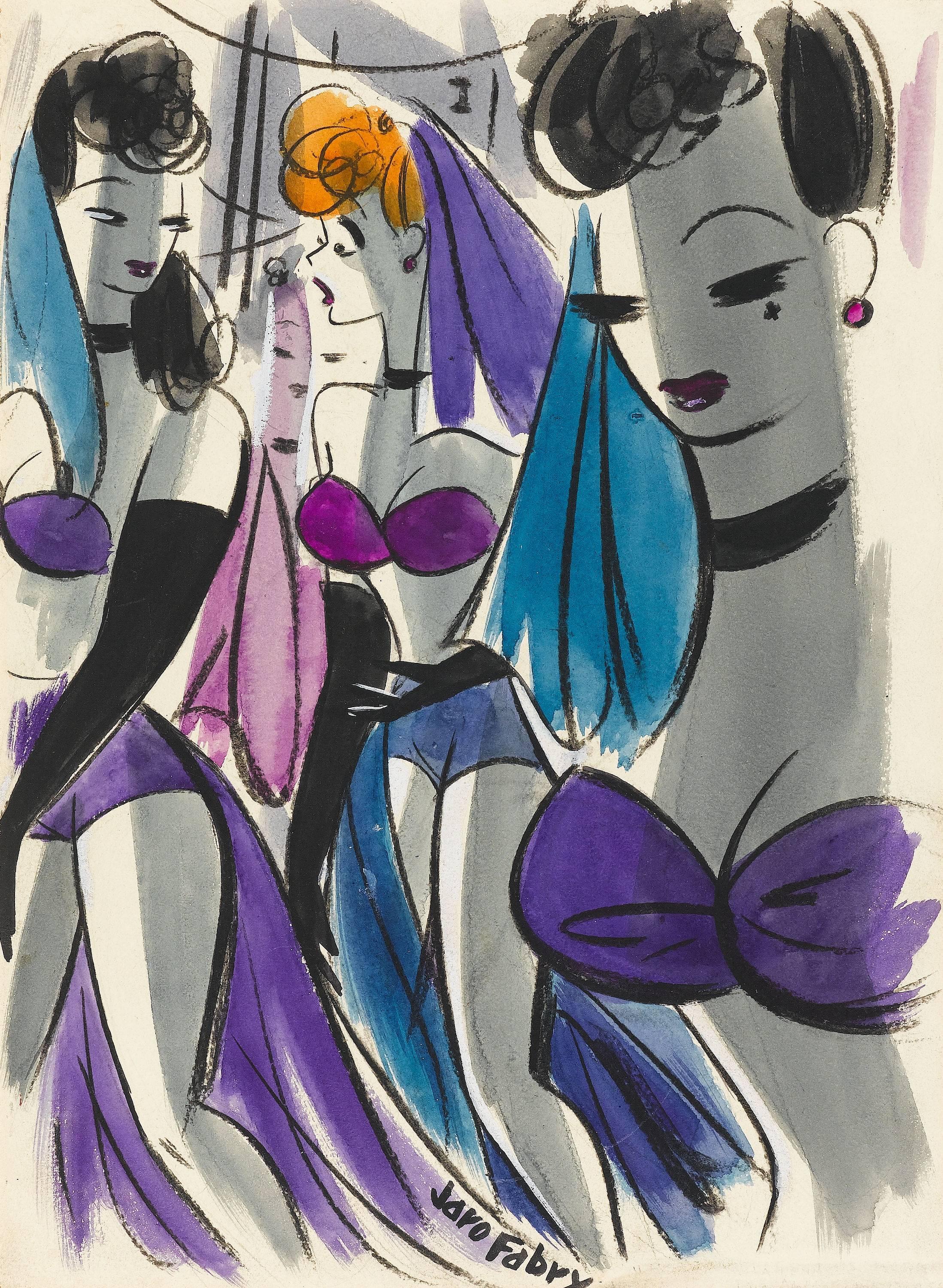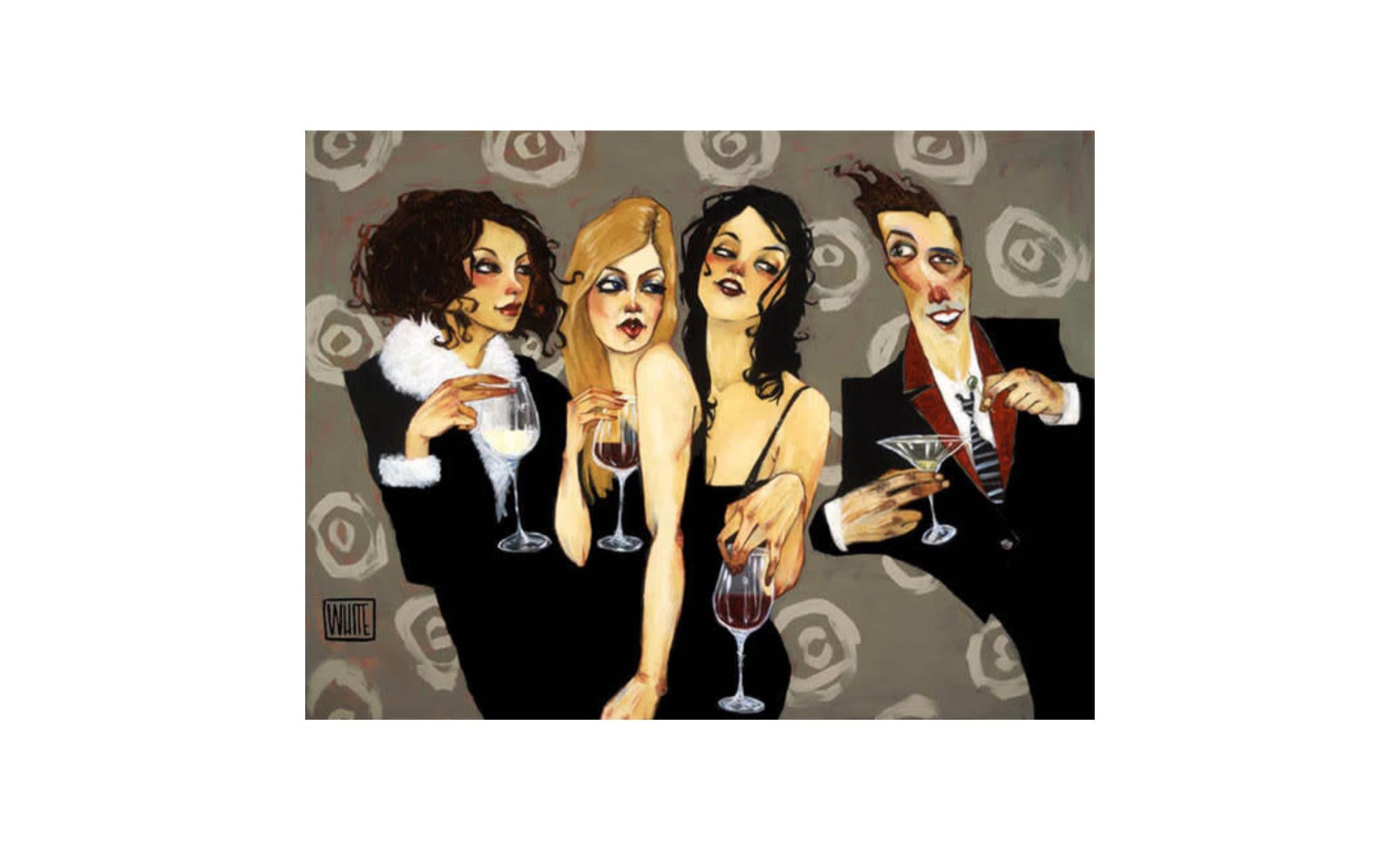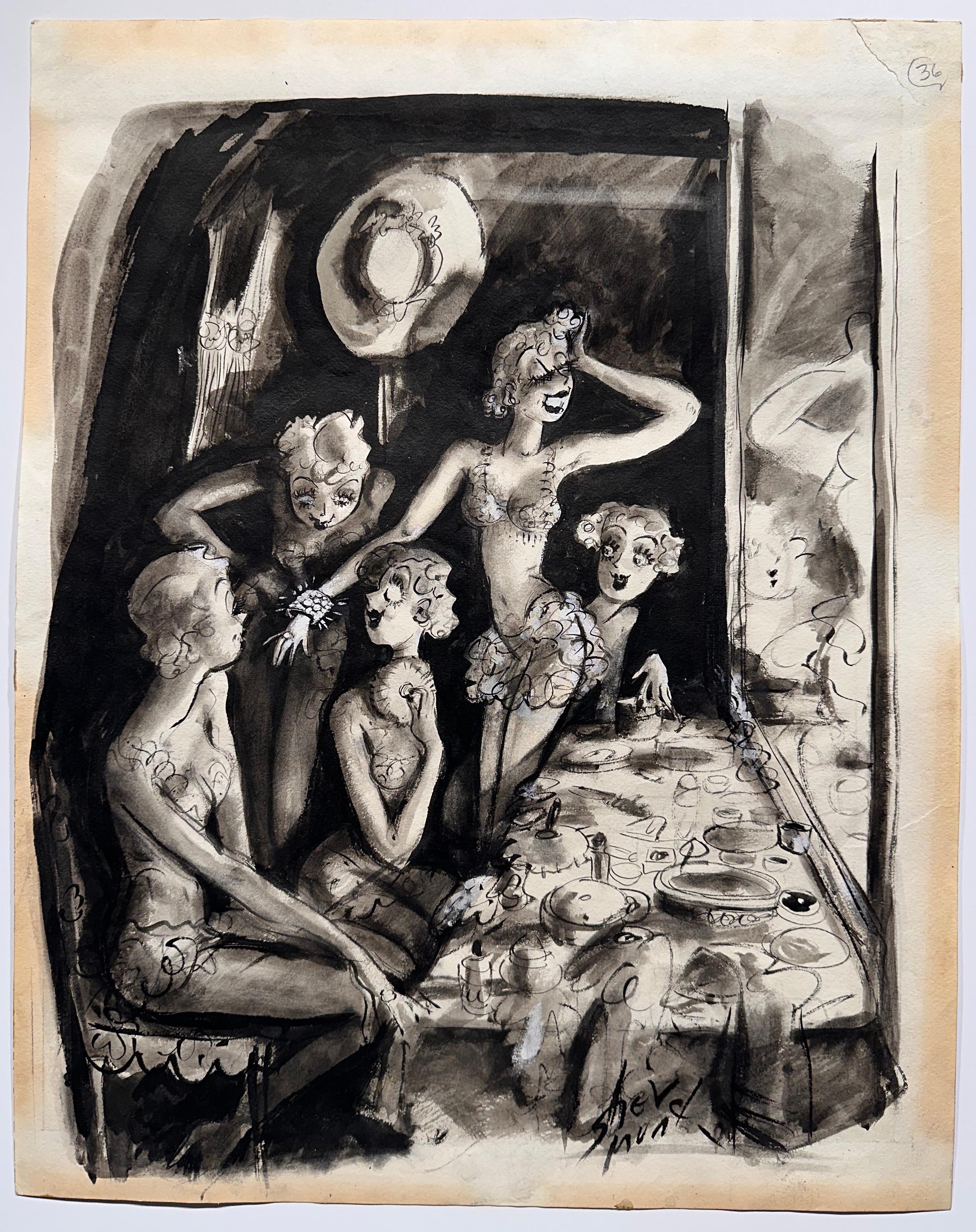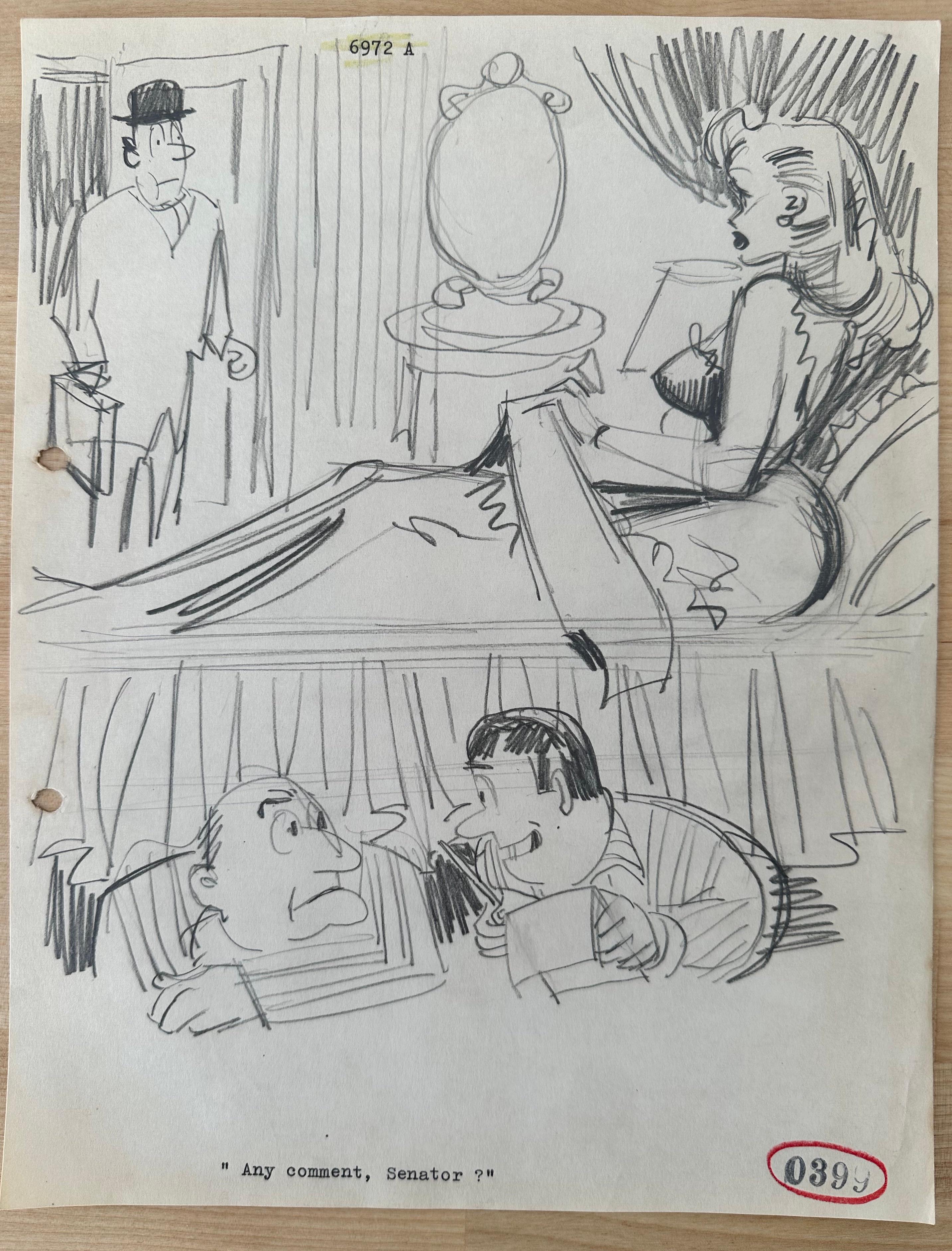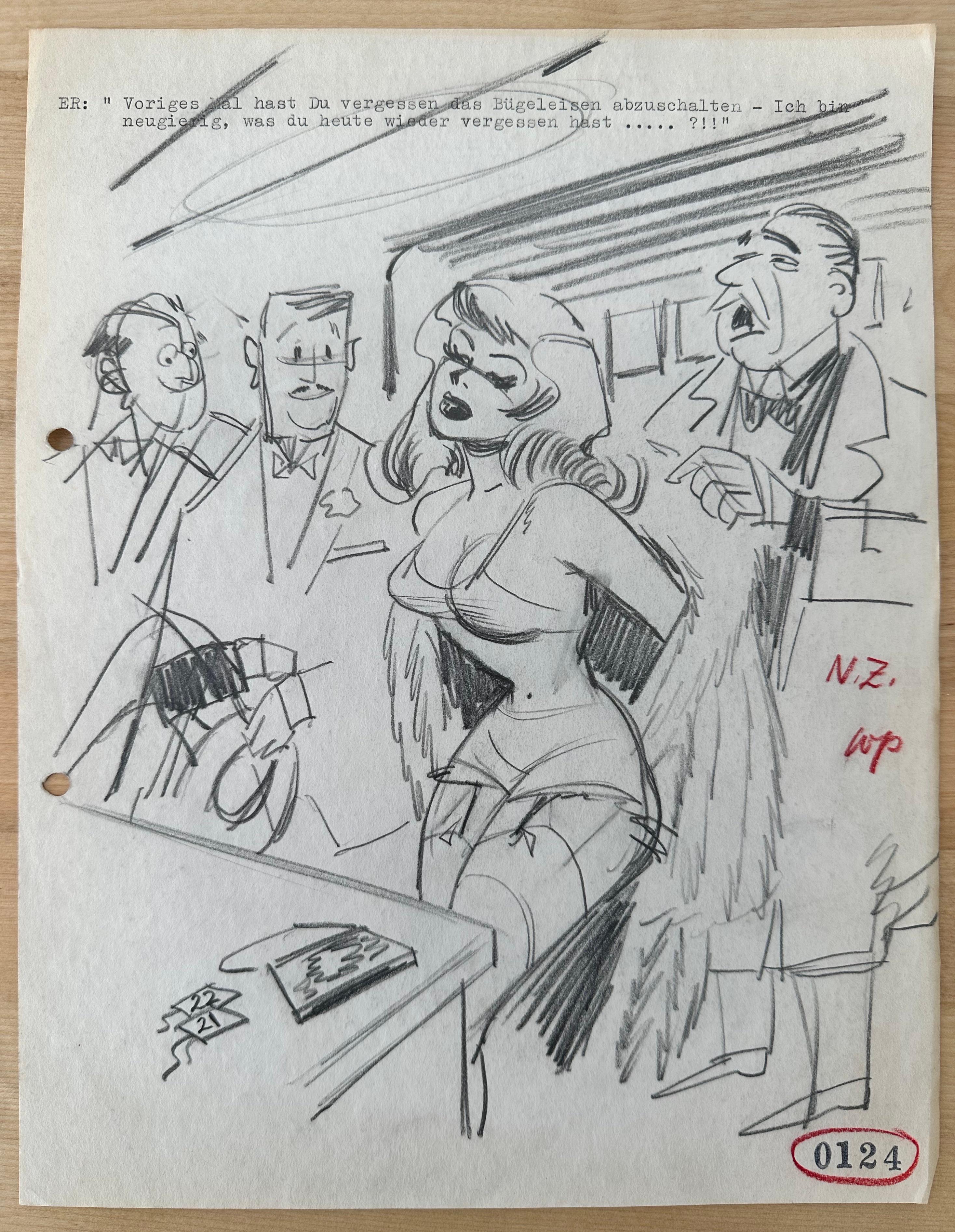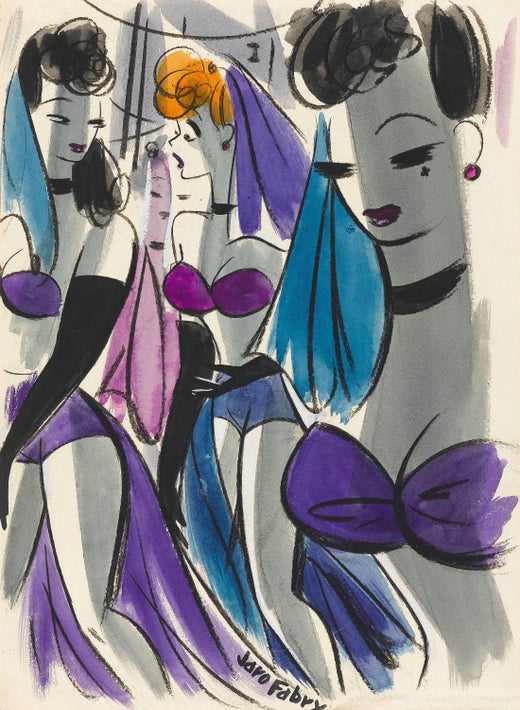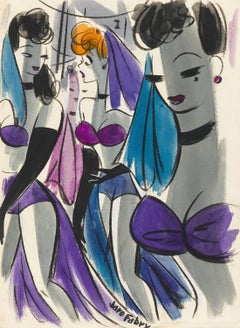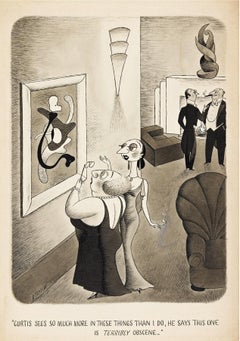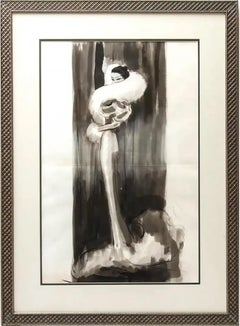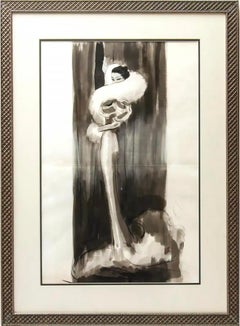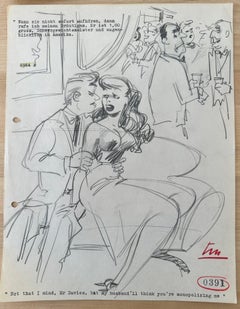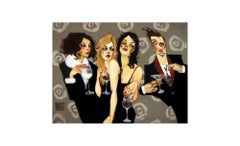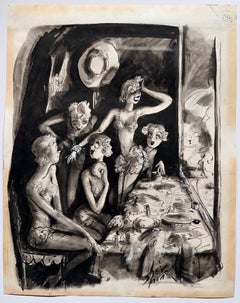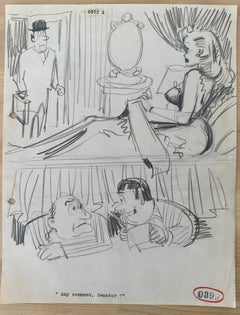Items Similar to Drunk man at party, Golden Age of Hollywood
Want more images or videos?
Request additional images or videos from the seller
1 of 5
Jaro FabryDrunk man at party, Golden Age of HollywoodCirca 1940's
Circa 1940's
$14,000
£10,613.92
€12,235.05
CA$19,716.75
A$21,864.42
CHF 11,488.13
MX$267,146.07
NOK 143,732.20
SEK 134,917.23
DKK 91,337.02
About the Item
During the Golden Age of Hollywood no illustrator chronicled the great stars, pin-ups and good girls better than Jaro Fabry, Work is Framed in a Modern Black wood frame.
- Creator:Jaro Fabry (1912 - 1953, American)
- Creation Year:Circa 1940's
- Dimensions:Height: 12 in (30.48 cm)Width: 16 in (40.64 cm)
- Medium:
- Movement & Style:
- Period:
- Condition:
- Gallery Location:Miami, FL
- Reference Number:1stDibs: LU38531290173
Jaro Fabry
Jaro Fabry was an artist and illustrator, working primarily in Hollywood from the 1930s until his death. He was a brilliant illustrator with a defined style of his own. There is not a brushstroke out of place in his works that appear loosely rendered. He was best known for his depiction of the Golden Age of Hollywood. Fabry’s work had appeared in The New Yorker, Collier's and many other popular magazines.

About the Seller
5.0
Gold Seller
Premium sellers maintaining a 4.3+ rating and 24-hour response times
Established in 2005
1stDibs seller since 2016
117 sales on 1stDibs
Typical response time: 1 hour
- ShippingRetrieving quote...Shipping from: Miami, FL
- Return Policy
Authenticity Guarantee
In the unlikely event there’s an issue with an item’s authenticity, contact us within 1 year for a full refund. DetailsMoney-Back Guarantee
If your item is not as described, is damaged in transit, or does not arrive, contact us within 7 days for a full refund. Details24-Hour Cancellation
You have a 24-hour grace period in which to reconsider your purchase, with no questions asked.Vetted Professional Sellers
Our world-class sellers must adhere to strict standards for service and quality, maintaining the integrity of our listings.Price-Match Guarantee
If you find that a seller listed the same item for a lower price elsewhere, we’ll match it.Trusted Global Delivery
Our best-in-class carrier network provides specialized shipping options worldwide, including custom delivery.More From This Seller
View AllArt Deco Glamour illustration, Golden Age of Hollywood
By Jaro Fabry
Located in Miami, FL
Caption: "He proposed this morning right
after the alarm clock went off."
From the Estate of Charles Martignette
Signed lower center
unframed
Category
1940s Art Deco Portrait Drawings and Watercolors
Materials
Ink, Watercolor
Art Lovers and Art Critics Analyzing Obscene Painting. Cartoon
By Richard Taylor
Located in Miami, FL
Cartoonist Richard Taylor was trained in academic art. He frequently comments on abstract art which was the new and radical thing at the time. "Curtis sees so much more in these thi...
Category
1940s Academic Portrait Drawings and Watercolors
Materials
Ink, Board
Vogue Magazine Illustration
Located in Miami, FL
"Mademoiselle X" story illustration
for Vogue February 1, 1934, watercolor and ink, reverse signed in pencil "Benito for Madame X," pencil inscription "Feb.1, 1934 / Page 51 / 316," ...
Category
1930s Art Deco Figurative Drawings and Watercolors
Materials
Paper, Ink, Watercolor
Art Deco Vogue Magazine Illustration
By Edouard Garcia Benito
Located in Miami, FL
Art Deco "Mademoiselle X" story illustration
for Vogue February 1, 1934, watercolor and ink, reverse signed in pencil "Benito for Madame X," pencil inscription "Feb.1, 1934 / Page 51 / 316," accompanied by corresponding issue of Vogue magazine...
Category
1930s Art Deco Figurative Drawings and Watercolors
Materials
Watercolor
Vanity Fair Illustration High Brow Types with Relationship Issues
Located in Miami, FL
Hight brow couple having relationship issues rendered in a black and white stylized Art Deco fashion.
In pencil the caption reads "Are you willing to divorce your wife the minute sh...
Category
1820s Art Deco Figurative Drawings and Watercolors
Materials
Paper, Ink, Graphite
Glamorous Performer in Art Deco Black Evening Dress, Golden Age of Hollywood
By Jaro Fabry
Located in Miami, FL
work is matted but not framed.
Golden Age of Hollywood no illustrator chronicled the great stars, pin-ups and good girls better than Jaro Fabr...
Category
1930s Art Deco Figurative Paintings
Materials
Crayon, Watercolor, Gouache
You May Also Like
Humorous Gentleman's Magazine cartoon
Located in Wilton Manors, FL
Cartoon sketch, ca. 1955. Pencil on paper, sheet measures 8.5 x 11 inches. Unsigned with editor's notations.
From a group of sketches meant to be preliminary drafts for editor appro...
Category
Mid-20th Century Figurative Drawings and Watercolors
Materials
Pencil
$125 Sale Price
50% Off
Intoxication At The Flower Lounge
By Todd White
Located in Toronto, ON
23" x 32" Unframed
Limited Edition Giclee on Canvas with Hand Embellishment of 195
Hand Signed by Todd White
Todd white captures restaurant, night and Hollywood scenes with contrasting colors serving the viewer’s eyes as those in his stolen scenes serve or are served-wine, coffee, cigarettes, cigars, and martinis. He creates timeless scenes of diverse attraction, of known intimacy. Within the exaggerated features and textured skin of his characters lies truth, yours and theirs. Distinctive bodies and details to lips, eyes, hair, skin, hands and what is held in each, separate and blend his characters’ lives. The smoke that rises from their lips, the drinks that linger at their fingertips, the clothing that adorns their bodies and the crowd created among lovers, friends, patrons and co-workers all speak a certain poetry. Each character depicts the subtleties of what one shows and what one hides. An asymmetrical face tells of an asymmetrical life, of how life wears and how we wear life — what we choose to carry in our hands and on our faces — how we wear ourselves, what smoke and color we stand in.
Todd’s paintings are captivating, demanding a second look, often invoking humor or thoughts of familiar feelings — I’ve been there, I know them. Above all, the work is infectious and has caught the attention of the public (galleries cannot keep enough of Todd’s work in stock) as well as celebrities (Vin Diesel, Hugh Hefner, Macaulay Culkin, Eric McCormack, Ryan Stiles and Joe Rogan are collectors of Todd’s oil paintings). But who is the artist behind the art and where did his unique style come from?
Todd began in at Warner Bros. Studios while working on the popular series, tiny toons. Through character clean-up and development, Todd began to forge his own artistic style. Shortly thereafter, Todd became part of the lead animation team for the internationally renowned cartoon, sponge bob square pants. Over the next three years, Todd sharpened his eye in storyboarding, illustration and character design.
Throughout this period, Todd privately experimented with style and concept, eventually arriving at a process which guides him through every piece. The impact is apparent in his paintings; Todd’s rat-pack-meets-Picasso style results, in part, from his desire to reveal his characters’ innermost thoughts and emotions on their faces. Todd likens his portraits to his favorite episode of the Twilight Zone in which people wore masks that later became their faces and revealed who they truly were.
Fast forward ten years later, and until Todd can conceptually see the story in his head, he refuses to paint a single signature knuckle curled around one of his famous martinis. "I actually name my pieces first and then i visualise each face and its personality. Then I develop each person’s story." The stark, unblemished delivery of his subjects is very much intended: whatever isn’t necessary to the story isn’t on my canvas. "I don’t waste a lot of time with backgrounds because they don’t interest me. They aren’t necessary. Instead i focus on what is essential. For example, the hands." Hands are a focal point for Todd, reflecting the subject’s state of mind as much as any body language or facial expression. Everyone’s hands are full of personality he surmises. Take Al Pacino; without his hands, he’s not nearly as interesting to watch.
In addition to more obvious influences, such as Austrian expressionist Egon...
Category
2010s Expressionist Figurative Prints
Materials
Canvas, Giclée
Life Magazine Art Deco Showgirls Cartoon
Located in Wilton Manors, FL
Barbara Shermund (1899-1978). Showgirls Cartoon for Life Magazine, 1934. Ink, watercolor and gouache on heavy illustration paper, matting window measures 16.5 x 13 inches; sheet measures 19 x 15 inches; Matting panel measures 20 x 23 inches. Signed lower right. Very good condition with discoloration and toning in margins. Unframed.
Provenance: Ethel Maud Mott Herman, artist (1883-1984), West Orange NJ.
For two decades, she drew almost 600 cartoons for The New Yorker with female characters that commented on life with wit, intelligence and irony.
In the mid-1920s, Harold Ross, the founder of a new magazine called The New Yorker, was looking for cartoonists who could create sardonic, highbrow illustrations accompanied by witty captions that would function as social critiques.
He found that talent in Barbara Shermund.
For about two decades, until the 1940s, Shermund helped Ross and his first art editor, Rea Irvin, realize their vision by contributing almost 600 cartoons and sassy captions with a fresh, feminist voice.
Her cartoons commented on life with wit, intelligence and irony, using female characters who critiqued the patriarchy and celebrated speakeasies, cafes, spunky women and leisure. They spoke directly to flapper women of the era who defied convention with a new sense of political, social and economic independence.
“Shermund’s women spoke their minds about sex, marriage and society; smoked cigarettes and drank; and poked fun at everything in an era when it was not common to see young women doing so,” Caitlin A. McGurk wrote in 2020 for the Art Students League.
In one Shermund cartoon, published in The New Yorker in 1928, two forlorn women sit and chat on couches. “Yeah,” one says, “I guess the best thing to do is to just get married and forget about love.”
“While for many, the idea of a New Yorker cartoon conjures a highbrow, dry non sequitur — often more alienating than familiar — Shermund’s cartoons are the antithesis,” wrote McGurk, who is an associate curator and assistant professor at Ohio State University’s Billy Ireland Cartoon Library & Museum. “They are about human nature, relationships, youth and age.” (McGurk is writing a book about Shermund.
And yet by the 1940s and ’50s, as America’s postwar focus shifted to domestic life, Shermund’s feminist voice and cool critique of society fell out of vogue. Her last cartoon appeared in The New Yorker in 1944, and much of her life and career after that remains unclear. No major newspaper wrote about her death in 1978 — The New York Times was on strike then, along with The Daily News and The New York Post — and her ashes sat in a New Jersey funeral home...
Category
1930s Art Deco Figurative Paintings
Materials
Ink, Gouache
$3,250 Sale Price
35% Off
Humorous Gentleman's Magazine cartoon
Located in Wilton Manors, FL
Cartoon sketch, ca. 1955. Pencil on paper, sheet measures 8.5 x 11 inches. Unsigned with editor's notations.
From a group of sketches meant to be preliminary drafts for editor appro...
Category
Mid-20th Century Figurative Drawings and Watercolors
Materials
Pencil
$125 Sale Price
50% Off
Humorous Gentleman's Magazine cartoon
Located in Wilton Manors, FL
Cartoon sketch, ca. 1955. Pencil on paper, sheet measures 8.5 x 11 inches. Unsigned with editor's notations.
From a group of sketches meant to be preliminary drafts for editor appro...
Category
Mid-20th Century Figurative Drawings and Watercolors
Materials
Pencil
$125 Sale Price
50% Off
Humorous Gentleman's Magazine cartoon
Located in Wilton Manors, FL
Cartoon sketch, ca. 1955. Pencil on paper, sheet measures 8.5 x 11 inches. Unsigned with editor's notations.
From a group of sketches meant to be preliminary drafts for editor appro...
Category
Mid-20th Century Figurative Drawings and Watercolors
Materials
Pencil
$125 Sale Price
50% Off
